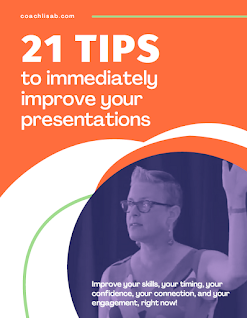Looking at the floor
 I recently gave a keynote address to a roomful of Toastmasters. Knowing of the expertise in the room, I asked one of the event organizers for some feedback. She said, "Don't look at the floor when you're thinking."
I recently gave a keynote address to a roomful of Toastmasters. Knowing of the expertise in the room, I asked one of the event organizers for some feedback. She said, "Don't look at the floor when you're thinking."Now that was some specific feedback. And you know what? I didn't even realize I was doing it! Usually I'm presenting a workshop or training, and working off of a page of notes in between group exercises and activities. I don't look at the floor because I'm busy interacting with my audience.
However, the keynote was different. All of my notes were in my head, and there was no flip-chart-writing or group discussion, so I was strictly the center of attention. While mentally working my way through the notes in my head, I would unconsciously look down at the floor while gathering my next thought.
But even if this person hadn't told me this, I would have discovered it anyway, because I videotaped myself. And sure enough, I could see myself looking down at the floor when I was transitioning to a new thought.
Do you videotape yourself when you're speaking? If not, you should. There are so many little quirks that we develop as speakers that we may not be aware of. Even the most seasoned pros have their little quirks. Before I found out about looking at the floor, I had recognized that I tend to hold my hands together in front of my body when I'm not gesturing, rather than letting them hang at my sides. Still working on this one!
Watching yourself on video may not be the easiest thing you've ever done, but it's an excellent tool for discovering your quirks, movements and vocal tics that may be distractions when you're presenting. Scott Ginsberg recommends watching your video at least three ways: at regular speed, muted and fast forward.
At regular speed, you can evaluate yourself at a leisurely pace, your voice, your movements, your interaction with the audience, and confirm which content worked and which didn't by noting audience reaction (and you're already doing this during your presentation, right?).
Watching the video muted allows you to focus on movement without the distraction of voice.
Watching on fast forward will magnify your movement flaws, especially the repetitive ones, so be prepared!
Before you give a presentation, find out if the organizers will be videotaping your talk. If not, bring your own camcorder or borrow one (with a tripod). You will learn so much about yourself as a speaker by viewing your presentations on video, and you get the opportunity to gain awareness of your own issues before someone else has to tell you!
What are your quirks as a speaker?
____________________________________________________
On The Everything Page you'll find everything you need to build visibility, credibility and influence through engaging presentations that move your participants into action: freebies, low-cost products and courses, and 1:1 coaching!



0 comments. Please add yours! :
Post a Comment